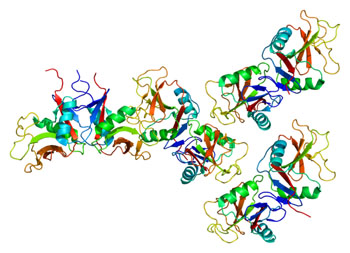LDL Receptor Expression Differentiates Myeloid-Derived Cells from Neutrophils
By LabMedica International staff writers
Posted on 17 Aug 2016
Cancer researchers have identified a surface protein marker on myeloid-derived suppressor cells (MDSCs) that differentiates them from normal neutrophils and may be a potential therapeutic target.Posted on 17 Aug 2016
Polymorphonuclear myeloid-derived suppressor cells (PMN-MDSCs) are important regulators of immune responses in cancer and have been directly implicated in the promotion of tumor progression. However, understanding the biology and clinical importance of these cells has been hampered by a lack of markers that set them apart from normal neutrophils.

Image: A molecular model of lectin-type oxidized LDL receptor 1 (Lox-1) (Photo courtesy of Wikimedia Commons).
To find a marker to differentiate MDSCs from normal neutrophils, investigators at the Wistar Institute (Philadelphia, PA, USA) partially enriched a PMN-MDSC fraction with gradient centrifugation and then determined that low-density PMN-MDSC and high-density neutrophils from the same cancer patients had a distinct gene profile.
The most prominent changes were observed in the expression of genes associated with endoplasmic reticulum (ER) stress. Low-density lipoprotein (LDL) was one of the most increased regulators, and its receptor - lectin-type oxidized LDL receptor-1 (LOX-1) - was one of the most overexpressed genes in PMN-MDSC. The Lox-1 receptor protein binds, internalizes, and degrades oxidized LDL.
Results published in the August 5, 2016, online edition of the journal Science Immunology revealed that Lox-1, encoded by the OLR1 gene, was practically undetectable in neutrophils in peripheral blood of healthy donors, whereas 5 to 15% of total neutrophils in cancer patients and 15 to 50% of neutrophils in tumor tissues were Lox-1 positive. Exposing neutrophils from healthy individuals to endoplasmic reticulum stress resulted in up-regulation of Lox-1 with subsequent increase in immune suppressive function.
“Before we started this work, the only way to isolate PMN-MDSCs was by density centrifugation of blood because they could not be properly identified in tumor tissue,” said senior author Dr. Dmitry I. Gabrilovich, leader of the translational tumor immunology program at the Wistar Institute. “Identifying a marker for PMN-MDSCs will allow us to study these cells in much more depth. In addition, if our clinical results are verified in larger studies, the marker could also be used to help physicians and patients make informed treatment decisions and, ultimately, it could be exploited to target PMN-MDSCs for therapeutic benefit.”
Related Links:
Wistar Institute








 (3) (1).png)





